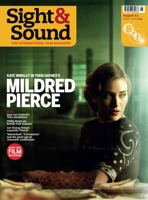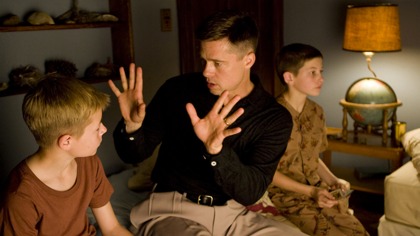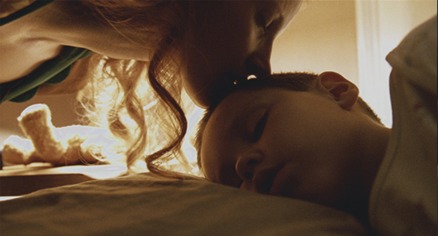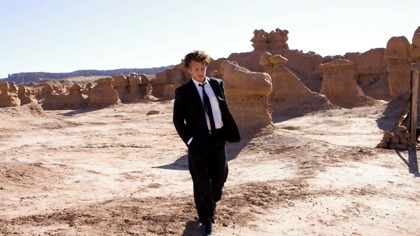Primary navigation


Intimate childhood memoir? Absurd sacred bluster? Michael Atkinson parses Terrence Malick’s ambitious Rorschach blot
As you may well have already deduced, Terrence Malick’s new hyper-reverie is an entirely unique launch into the present-moment film-culture ether – an ambitious Rorschach blot that is almost exactly as pretentious and unwittingly absurd as it is inspired, evocative and gorgeous. It often seems to have been deliberately calibrated to divide its viewership into warring camps, to intoxicate the Malickians into awestruck swoons just as it produces scoffings from the sceptics and stupefies the average filmgoer. But that presumes Malick considers a viewership at all – which he may not, and if there are many, many ways to look at The Tree of Life, which seems already to be a film that’s more interesting to argue about than to actually watch, then it’s difficult to shake the sense of it as the spectacle of a man gone deep-sea diving in his own navel.
Still, the hand-to-heart camp proclaims, Malick’s navel is a spectacular place, and he is a transcendent guide. To each his own epiphany. I, just so we’re clear, have not been a Malick sceptic until now; his 1970s double-hitter ages beautifully, and The Thin Red Line (1998) is an epochal explosion of broken hearts, adrenal fever and genre-movie subversions. The New World (2005), for all its historical pathmarks, played like a sweet chapter elided from the previous film, with much of the same visual and tonal vocabulary. The new film indulges in the same battery of lyrical flourishes – tracking shots through wind-waving grass, Vermeer-ish light through open windows, whispered quasi-poetic narration, tree canopies splintering the sun, magic-hour duskiness etc, the images beautifully shot by Emmanuel Lubezki – but immediately also takes off into nether regions and isolated oases that defiantly test any reasonable viewer’s credulity.

The Texas family at the film’s viscous centre is introduced in fragmented swatches; we’re introduced to Brad Pitt’s embittered Dad and Jessica Chastain’s angelic Mom in their middle years (though they’re not visibly aged), when they receive a telegram indicating a grown son’s death. Which son we’re not sure, but we know there are three, and one grows up to be a dyspeptic Sean Penn, brooding around Dallas skyscrapers. Then before we know it the film wordlessly enters into a massive chapter that, like a James A. Michener mega-novel, visits the gas-and-fume origins of the Earth, from abstracted galactic explosion to volcanic eruption to microbial growth to the predatory lives of state-of-the-art digital dinosaurs. Like the first and last acts of 2001 turned inside out (FX master Douglas Trumbull came out of retirement, and Jupiter is glimpsed, God knows why), or a BBC nature special without the narration, this passage is The Tree of Life’s crucifix, upon which it either dies a lowly mortal movie or becomes reborn as something holy, its fate dependent entirely on your tolerance of or hunger for unleashed and ambiguous cosmic revelation.
Then the family begins, with babies and Waco suburbia and endless dusks, and the best opportunity offered here is to take the movie as a Malick memoir, in which case the ellipses and idealisations and fiery textural moments (a butterfly, a touch, an exultant running, a satin chemise) make enchanting personal sense. This way, The Tree of Life becomes an extended ‘experimental’ film à la Brakhage or Mekas, or even a home movie re-envisioned, re-enacted and saturated with nostalgia. Critics have only wondered idly about this textual notion, and Malick would apparently prefer we don’t follow this thread, but it’s true enough: he was born in Waco to a petroleum company geologist (as is Pitt’s incarnation) and an Irish mother (Chastain is a pale-skinned ginger flame), and had two brothers, one of whom committed suicide as a young man, living in Spain. (Ninety-four-year-old Emil Malick still lives in Bartlesville, Oklahoma, where Malick grew up.) There’s a visionary sweetness to Malick’s memoirising, but also a narcissistic grandiosity, uniting all his present and past selves, dead and living loved ones, on a vast beach under a liturgical chorus, and considering the mystery of his own birth by returning to the origins of primordial ooze.
Does Malick think the universe shines out of his ass? Do you? It would’ve helped if Malick’s eulogising his family and his brother had more blood in its stock. (Compare how Bergman essayed his childhood, in rich and dramatic detail over four heady screenplays, or the acidity and irony brought to childhood memoirs by Truffaut, Woody Allen and Alexei German.) On the evidence, the filmmaker knows nothing but a child’s worshipfulness for his peaceful, nurturing, Raphaelite mother, and something of a rueful contempt for his martinet dad, whose brutal fathering habits and festering regrets about an abandoned music career provide The Tree of Life with its only dramatic percolation, simplistic though it is. Malick attempts in several ways to suggest a replay of the story of Job that just seems half-hearted, and a running thematic dialogue between self-sacrificing grace (mother) and selfish, self-directed Nature (father), but the religious intonations and parabolic auras don’t suggest the complex view of a retrospective adult, only the dreamy feelings of the kid, stuck in a rather ordinary family conflict.

Malick, of course, is enough of a magician to craft breath-catching moments by the dozen; he stays close enough to the boys (particularly Hunter McCracken as discontented Malick avatar Jack and Laramie Eppler as doomed, favoured middle son R.L., resembling Pitt to a startling degree) to nail this particular experience of boyhood to the wall for all time – the endless lawns and wide streets, the spaces between houses and neighbourhoods where adults can’t find you, the idle moments among friends in the woods thinking up something dangerous with which to fill up a summer afternoon. Without the dizzying assault of sacred bluster (and the occasional mytho-surrealist touches, like levitation and Sleeping Beauty’s glass coffin, which simply scan like ideas Malick had and then gave up on), the film might have been an intimate and evocative masterpiece, an anthropological ode to a lost America. But who among us can begrudge the besotted Malickians if, in their woozy ardour, they’ve found exactly that and more?
Bergman the changeling?: Geoffrey Macnab on the late Swedish master’s posthumous family wrangles (June 2011)
The Tree of Life: three anecdotes: Gabe Klinger has his ear to the ground at the film’s Cannes premiere (May 2011)
The Thin Red Line reviewed by Michael Atkinson (DVD, December 2010)
Popcorn patter: David Thomson rediscovers Badlands (September 2008)
The New World reviewed by Amy Taubin (February 2006)
The Thin Red Line reviewed by Geoffrey Macnab (March 1999)
Bayonets in paradise: Colin MacCabe on The Thin Red Line (February 1999)